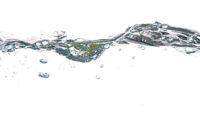Pure unsaturated oils, even in favourable humidity and temperature conditions (20 °C, RH 50%), take a very long time to dry. The same oil boiled in a copper jar or in a vessel containing pieces of copper or lead metal dries over a relatively short amount of time. Varnishes were prepared in such a way in the Middle Ages. The content of metal derivatives, so called driers, promoted a rapid drying process. Further development of this technology led to oil paints used first by artists and later by the general public. In the beginning, paints were manufactured in small quantities, and the formulas were kept as family secrets. The first paint factories began during the European technical revolution in the eighteenth and nineteenth centuries. During that time some research was done and published in the technical literature. During the same time, the manufacturing method of driers based on the reaction of metal oxide with rosin acids was described. The same method is used today, and there are many descriptions of it.
Oil and Resin Drying Process
Used for centuries as binders in coatings, oils contain reactive carbon-carbon double bonds in the aliphatic chains; chemically they are triglycerides of unsaturated fatty acids. The drying process is a chemical reaction of unsaturated carbon-carbon double bonds with atmospheric oxygen i.e., oxidative polymerization. In this way low-molecular-weight unsaturated triglycerides transform into high-molecular-weight polymers suitable for film formation. The reactivity of oil in the polymerization process depends on the amount and location of reactive double bonds and the chain structure. Because of polymerization and drying rate, oils are often classified as drying, semi-drying and non-drying. The last group is of very little interest in coatings.
In paints manufactured today, alkyd resins are used as binders instead of oils. Alkyd resins are prepared during the condensation process of saturated and unsaturated dicarboxylic acids with polyalcohols and oils. Different alkyd resins are obtained depending on the type of fatty acid, oil and alcohol. Very often phthalic anhydride is used as the dicarboxylic acid precursor, hence the common use of the name phthalate resins for some alkyd binders. Depending upon how much oil is used in the cooking process, the resin may be a long oil type, a medium oil type or a short oil length. Moreover natural resins like copal, dammar, accroides, sandarac, elemi, rosin and shellac are applied as binders for some specific solventborne coatings.(3) In some cases, chemical modification is needed to improve natural binder properties.
During the low-thickness coating air drying process, an alkyd resin reacts with oxygen from the air, yielding hydroperoxides. The reaction is facilitated in the presence of cobalt salts. In the next reaction step, hydroperoxides form free radicals, starting the oxidative polymerization process. This second process is sped up in the presence of manganese salts.
RH + O2 + cat. Co2+ ® ROOH
ROOH + Mn2+ ® RO· + ·OH + Mn2+ ® RO· + OH- + Mn3+
ROOH + Mn3+ ® ROO· + H+ + Mn2+
The reaction sequence presented here is catalyzed by small amounts of organic metal salts called driers or siccatives. Organic radicals formed in the process react with double unsaturated chains, forming more reactive conjugated double bonds responsible for polymerization and further film drying reactions.

|
| Table 1 Click to enlarge |
Driers - Composition and Mechanism of Catalysis
Driers are metal (often polyvalent) carboxylates, some-times called metal soaps or salts. Typically cobalt, lead, iron, manganese, vanadium, calcium, strontium, zirconium, zinc, lithium and barium metals are used. The organic component of the drier is comprised of medium- to long-chain linear or branched acids like linoleic, naphthenic, abietic, decanoic, neodecanoic or octanoic. The organic part of the salt improves solubility in solventborne systems. Driers are commonly sold as a solution in aliphatic or aromatic solvent. More and more often, not.
Driers in Water-Based Alkyd Systems
Water-based alkyd resins are used as binders, often as a mixture with acrylic dispersions in waterborne interior and façade paints and also in enamels for wood and inorganic surfaces. The other possibility is an application of a hybrid alkyd/acrylic dispersion as a sole binder. Water-based alkyd resins are prepared from resins containing acid groups by neutralization with amines, often in the presence of surfactants. Proper resin acidity is obtained by introduction of sulphonic or carboxylic groups into the carbon backbone chain.(9) To prepare the alkyd emulsion, the phase inversion technique is often used, in which water is added to the resin/surfactant mixture. At the first moment that a water-in-oil emulsion is obtained, with more water an inversion occurs to an oil-in-water emulsion.(10) Generally in water-based alkyd/acrylic systems the acrylic part of the binder dries by a physical process (water evaporation and particle coalescence leads to film formation), and the alkyd part of the binder dries via the oxidative polymerization process catalyzed by driers. Initially, driers typical for solventborne systems were used in waterborne formulations.
Because of side reactions with water, amines and other dispersion paint ingredients, driers that are more stable and still reactive are needed. Carboxylates and naphthenic salts in the presence of water undergo hydrolysis, and as a result the availability of metal cations in the organic phase decreases dramatically during paint storage, yielding an increased coating dry time or lack of drying. To overcome this issue, drier complexes with amines and alcohols were introduced. Standard siccatives for solventborne systems may be applied in water-based systems after premixing with nonionic surfactants. Metals used in the drying process are prone to hydrolysis; their reactivity towards water increases as follows: Ba2+ < Ca2+ < Mn2+ < Zn2+ < Co2+ < Zr4+.4 Because of side reactions (e.g. hydrolysis) the efficiency of driers in water-based systems is lower, and compared to solvent-based formulations usually a 100% excess of standard siccative is needed. A special class of water-dispersible driers for waterborne alkyds was developed to overcome this drawback. Such additives may be easily incorporated during the let down process. The iron complexes with ascorbic acid derivatives are very effective in solventborne and waterborne systems in concentrations below 0.1%. Drier activity is even higher than manganese and comparable with the activity of cobalt salts.(8)
Coating Defects Connected with Drier Application
Typical defects result from either too low or too high a dosage of drier in the coating. Too low a concentration of siccatives increases the drying time, in the extreme situation it is responsible for lack of drying. On the other hand, too high a drier dosage reduces coating flexibility and makes the film brittle. Surface drying may stop oxygen diffusion into the entire coating layer and be responsible for non-uniform drying and bad weathering properties of the dry coating. The other issue is wrinkling, especially in the case of cobalt or manganese over dosage. Paints containing carbon black, some types of titanium dioxide or some organic pigments may lose their initial drying properties (loss of dry effect) during storage; the addition of wetting (mainly calcium) driers in the milling step is beneficial. The amount of individual driers depends on the paint formula and seriously influences both surface- and through-drying time. In the typical case, three types of driers are used: active drier, auxiliary drier and wetting drier. Too small an amount of active siccative reduces the surface drying, too little auxiliary siccative reduces through dry time and too little wetting siccative causes the loss of dry effect during storage.
Conclusions
Driers as paint additives are commonly used to promote curing of alkyd solventborne and waterborne coatings. Three different types of driers (active, auxiliary and wetting) are used in the typical paint composition. A proper drier content in the formulation is crucial for paint and coating properties. The amount of driers strongly influences coating properties and should be established in the paint formulation in the empirical way. In waterborne formulations, standard driers are used in excess. Another possibility is to use driers dedicated to waterborne systems. Much research has been done to develop environmentally safer substitutes for cobalt drier. The most promising results are obtained with iron and manganese complexes.
This paper was presented at ACT 10 (Advances in Coatings Technology), November 2010, Katowice, Poland. For more information, contact the author at muminski@wp.pl.






Report Abusive Comment